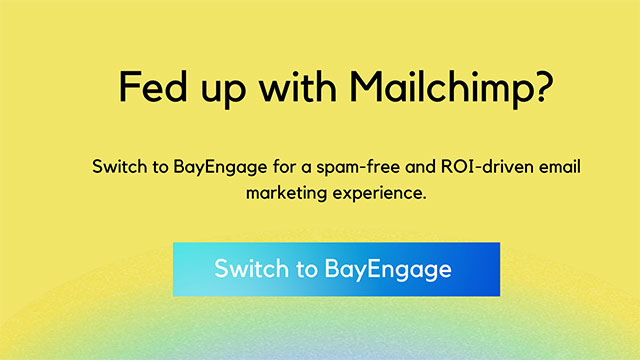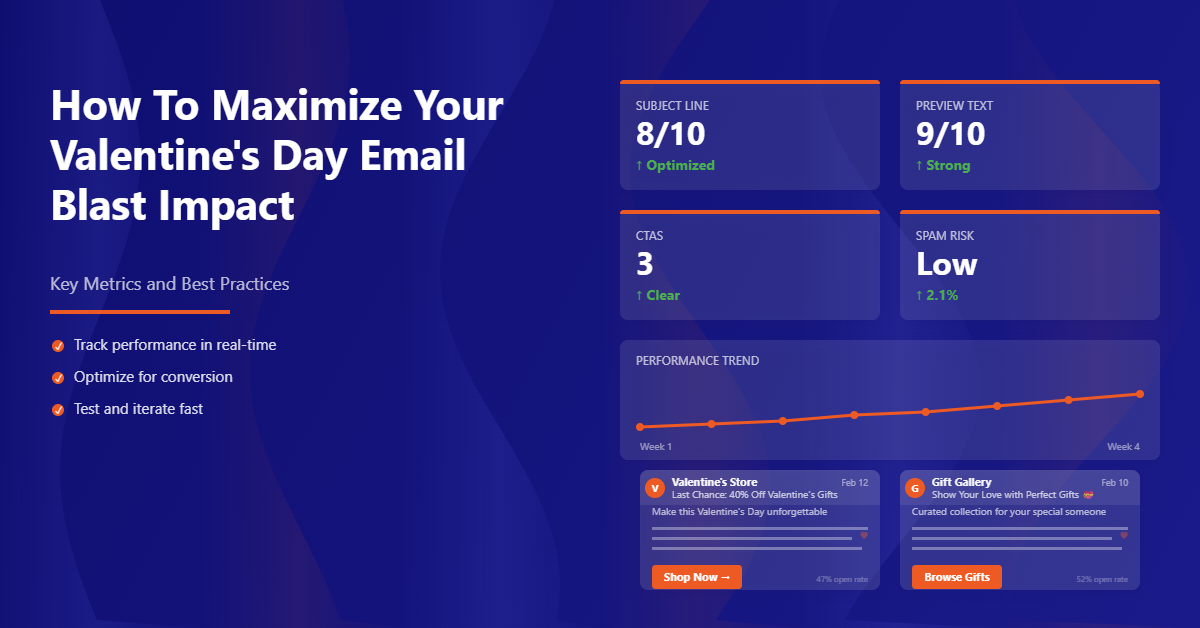Mailchimp: An Overview
Introduction
Let’s take a trip down memory lane.
It’s the year 2001 and the Harry Potter series has just begun.
The eighth season of the popular TV show FRIENDS was on the air.
Going to the movies cost $5 and Burberry was in fashion.

In a parallel space, the world of SaaS was booming, and little did Ben Chestnut or Dan Kurzius know that their web design agency (Rocket Science Group) would grow into a humongous email marketing tool (Mailchimp).
The idea of Mailchimp when it sprouted was to help small and medium businesses accomplish their email marketing goals without having to spend a ton of money.
In 2007, the founders decided to focus completely on Mailchimp. Their customers loved the product and the brand became a charm with its mascot, Frederick von Chimpenheimer aka Freddie.
As a brand, they’ve evolved a great deal and have time and again been experimenting with refreshing new designs that made them friendly, quirky, and approachable.
With their engaging copies and unique product engagement strategies, Mailchimp ruled the email marketing space in the 2010s and 2020s and gained a lot of market share.
Now that being said, let’s travel back to the present, 2021.
People are still crazy about Harry Potter and rewatching Friends for the zillionth time, not to mention the millennials’ love for Burberry.

Two decades later, Mailchimp also continues to be a good brand, and for a fact it is not just an email marketing tool but a marketing automation platform with a suite of features like social posting, digital ads, a Marketing CRM, shoppable landing pages, postcards, and more.
But, things have changed.
Mailchimp is not the monopoly when it comes to email marketing.
In the course of two decades, a lot of Mailchimp users got their hands dirty with other promising tools.
With many tools that have made promising strides and Mailchimp email failing its users on many aspects, it’s time to understand what went wrong and what other Mailchimp alternatives are worth trying.
Major issues with Mailchimp and the way out
Here’s a complete breakdown of the common pitfalls of Mailchimp curated from research and user woes on community forums.
- Limited collection of templates
Mailchimp has a small collection of templates (only 2 eCommerce themed templates in the free plan and overall only 15 templates)
- Mailchimp emails landing on spam
Mailchimp email users have been struggling with their emails going to spam which affects their deliverability rate and overall reputation
- No option to pay only for the subscribers
One of the major pitfalls of Mailchimp email is that you cannot pay only for the subscribers you have. This makes Mailchimp insanely expensive
- No access to critical features in the free plan
All essential features like access to templates and automation are all locked in the free plan
- Limited signup form templates
Mailchimp email has basic signup form templates and the number is also limited. Mailchimp has only 4 signup form templates
- No in-built stock image library
Mailchimp does not have an in-built stock image library that makes it difficult for users to make their emails aesthetically stunning
- No 24*7 email and chat support
Mailchimp does not offer email and chat support in their free plan which makes it difficult for the users to get the best value
- Does not integrate with Shopify
Mailchimp and Shopify parted ways in 2019 and Shopify users cannot install Mailchimp for their email marketing requirements from the Shopify app store
Critical Email Marketing & Mailchimp Stats You Must Know
- Users who switched from Mailchimp to BayEngage had 29.03% more open rates
- On average, BayEngage users see a whooping 3.09% click-throughs for their campaigns
- After switching to BayEngage, the email bounces drastically fell to 0.08%
- Mailchimp users who switched to BayEngage saw an email deliverability rate of 99.34%
- Mailchimp users reduced their spam score to 0.04 % after switching to BayEngage
- Users were able to solve their queries quickly with BayEngage’s support and save 2.5 hours as compared to Mailchimp
- Users who switched from Mailchimp to BayEngage were able to save more than $100 while also getting more value from the tool

BayEngage: An Overview
The Best Mailchimp Alternative: Introduction
BayEngage is an email marketing tool that helps marketers and eCommerce businesses across the globe scale their email marketing to a whole new level. With 300+ ready-to-use templates, powerful segmentation, and next-level automation capabilities BayEngage makes email marketing a successful revenue-generating channel for all online businesses.

BayEngage’s Features: What Makes It One Of The Best Mailchimp Competitors
Here’s a quick overview of BayEngage’s features that makes it better than Mailchimp:
- BayEngage has a huge collection of 300+ email templates covering a multitude of use cases which makes it one of the best Mailchimp alternatives out there
- Easiest drag and drop editor to create code-free emails in a snap
- A/B test email campaigns by experimenting with several variables like subject lines, time of sending, and the sender’s name
- Powerful segmentation to automatically categorize contacts based on behavioral and transactional data
- The automation feature has three recipes: shopping cart abandonment, post-purchase, and customer win-back to optimize customer engagement at every touchpoint
- BayEngage has an in-built library of millions of stock photos and a vast collection of emojis to make emails aesthetically stunning
- With BayEngage, you can also build subscriber lists through signup forms. With pop-up templates and the ability to set up the timing, frequency, viewers, and more – all it takes is just 3 minutes to implement a pop-up

BayEngage is custom-built for eCommerce businesses and has a ton of solid integrations.
BayEngage: The Roadmap
The product team thrives to improve BayEngage and give users the best results for their email marketing efforts. We’ve been working hard on rolling out more automation recipes that will help you build an email automation funnel to generate long-term revenue for your business. When we roll that out in a few months, BayEngage will be loaded with automation recipes that can help you scale your eCommerce businesses to a whole new level.
How can BayEngage Bridge The Gaps For a Mailchimp User?
BayEngage is significantly a better alternative to Mailchimp email in various aspects. Before we deep dive into it, here’s a quick overview of Mailchimp VS BayEngage:
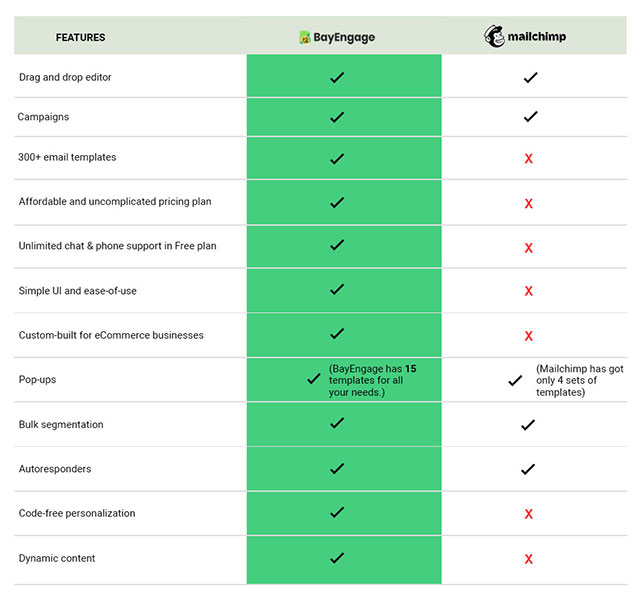
Here’s a detailed feature-wise comparison of BayEngage VS Mailchimp
- 300+ Email Templates
BayEngage is loaded with pre-built professionally designed templates. It covers a variety of use cases across types, seasons, and industries that span across 47+ categories.
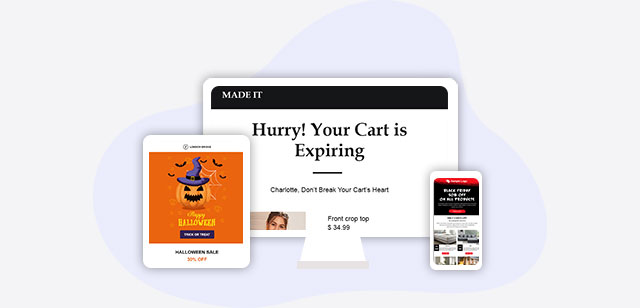
Here’s a list of categories across which BayEngage has templates that makes it one of the best Mailchimp alternatives.

What’s in Mailchimp?
Mailchimp has a very limited collection of templates and particularly, the eCommerce category has 15 templates of which only 2 are available in the free plan.
- 99% Deliverability rate
BayEngage uses APIs (Application programming interfaces) instead of SMTP servers that ensure a whopping 99% deliverability rate.
One of the key concerns for any user of an email marketing tool is a good email deliverability rate and emails not landing on the spam folder. BayEngage takes extra care and caution when it comes to sender reputation and email success.
What’s in Mailchimp?
Mailchimp has a lot of users who are disappointed with email deliverability and emails landing on spam. Here’s a sneak into what the users of Mailchimp have to say about Mailchimp not working for them – across several social channels and community forums.
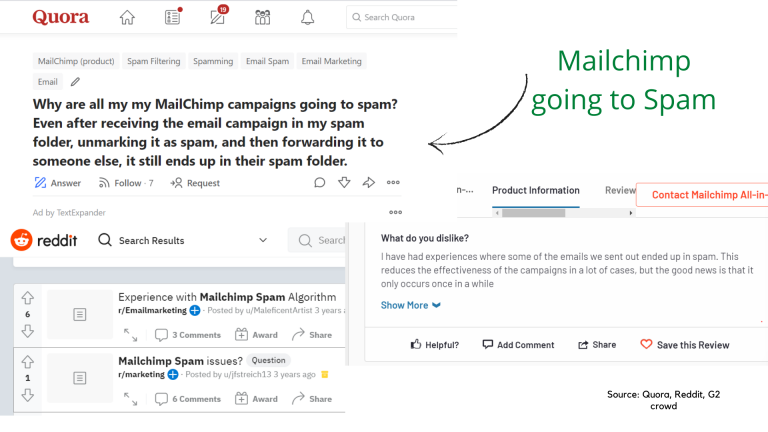
Affordable Pricing
The free plan in BayEngage helps users explore all the features without any limitations.
The accessibility of all the modules within the app has no restriction right from the free plan to the highest-paid plan.
Pay Only For Active Subscribers On BayEngage
Unlike Mailchimp, you pay only for active subscribers in BayEngage. Whereas, Mailchimp charges you for all of your contacts.
This is because BayEngage is built with the core intent of helping eCommerce businesses ace their marketing.
What’s in Mailchimp?
But, on the other hand, Mailchimp has a very complicated pricing plan. The free plan does no good to the user because all the essential features are locked. Also, the user has to keep increasing the price they pay to be able to access the best of their features.

- Signup Forms
BayEngage has 15+ signup forms templates that can help you instantly create pop-ups and acquire subscribers. It is pretty simple to set up a signup form on BayEngage – all you have to do is configure the display timing, frequency, display devices, and more on the app and set it active.
You can also set up auto-responders.

What’s in Mailchimp?
Mailchimp barely has 4 signup form templates which makes it difficult for users to instantly plug and play their messaging for a myriad of use cases.
- Unlimited chat and phone support
One of the biggest strengths of BayEngage is the unlimited dedicated phone and chat support for all users irrespective of the price they pay. We take user experience very seriously and are available 24*7 to make sure that users of BayEngage have the best experience possible.
What’s in Mailchimp?
Mailchimp’s phone and chat support like most of its other essential features are not available in the free plan. Not just that, Mailchimp’s support has standard responses for your queries which makes it difficult for the users to solve and sail out of their issues with the tool. Users of the tool often complain about Mailchimp not working well for them owing to a lack of support.
- Custom-built for eCommerce businesses
BayEngage helps eCommerce businesses significantly improve their email marketing ROI with its powerful features – 300+ email templates, segmentation, automation, pop-ups, and more.

What’s in Mailchimp?
Mailchimp does not cater specifically and exclusively to eCommerce businesses. Right from the templates collection to the automation capabilities, an eCommerce business can only find very meager value in Mailchimp.
- Millions of stock images
BayEngage has an in-built library of millions of stock images and all you have to do is use a keyword on the search bar and fetch a ton of results. With an easy drag and drop, these images can be used in emails.
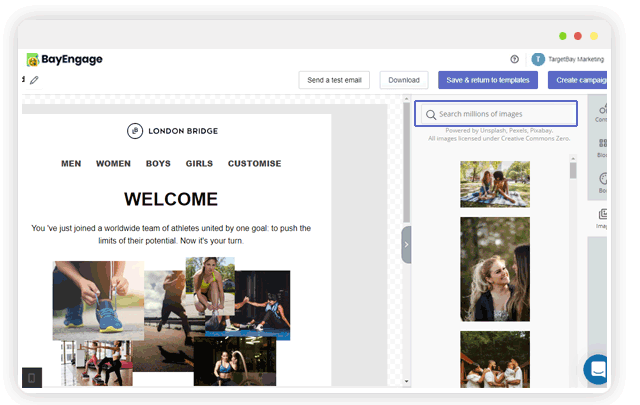
What’s in Mailchimp?
Mailchimp has a tangled process for finding stock assets and using them in emails. These complex integrations interrupt the ease of creating emails.
Find more Mailchimp competitors in this comprehensive list of Mailchimp Alternatives.
FAQs
1. Is BayEngage free?
BayEngage is free to use. We allow users to send 2500 emails per month for up to 250 subscribers.
2. I am a Mailchimp user. Why do I need to switch?
You must consider switching because BayEngage offers the same features as Mailchimp at much more affordable pricing. Not just that, BayEngage solves the problem of template designing with a huge collection of 300+ templates for every use case, holiday, or event that you could possibly think of!
3. What makes BayEngagae a better Mailchimp alternative?
With the same features and an edge over certain aspects like affordable pricing, excellent support, a huge collection of templates, and ease-of-use BayEngage is definitely your best bet!
4. Can I migrate my data from Mailchimp? How seamless is the process?
Migrating all your data is as simple as a click. You can also avail BayEngage’s free migration services to make the switch absolutely seamless.
5. What is a cheaper alternative to Mailchimp?
BayEngage is a cheaper Mailchimp alternative because you pay only for active subscribers and not based on the contacts.
6. Is there a better system than Mailchimp?
Yes, there absolutely is! Try BayEngage for an ROI-driven and spam-free email marketing experience.
Wrapping Up
2001 or 2021, your interest in fashion, movies, and television shows can change.
But, your love, commitment, and loyalty to a product should not.
A great product is one that is consistent in its efforts to provide the best of features, experience, and that hones itself to meet the ever-changing and evolving needs of the customers.
Mailchimp has done a tremendous job in making the email marketing space lucrative for its users – but again, that’s a thing of the past.
With a lot of users facing disappointment with the tool, it makes us wonder should they pass on the crown to more promising Mailchimp competitors?
Let us know your thoughts.





